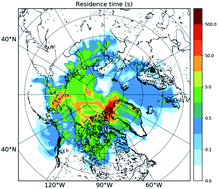Ice nucleating particles in the Canadian High Arctic during the fall of 2018†
Abstract
Ice nucleating particles (INPs) are a small subset of atmospheric particles that can initiate the formation of ice in clouds, including mixed-phase clouds. Here we report concentrations of INPs during October and November of 2018 at Alert, Nunavut, in the Canadian High Arctic. Our results show that average INP concentrations in October were higher than those in November. Based on an ammonium sulfate assay, mineral dust was an important component of the INP population at temperatures (T) ≤ −21 °C and T ≤ −20 °C for October and November, respectively. Based on a heat assay, biological particles were an important component of the INP population at T ≥ −21 °C and T ≥ −16.5 °C for October and November, respectively. In addition, INP concentrations were correlated with aluminum concentrations (a tracer for mineral dust), possibly suggesting a significant fraction of the mineral dust and biological INPs came from the same source. Particle dispersion modelling and correlations between INP concentrations and aluminum suggest a significant fraction of the INPs came from ice-free and snow-free land at latitudes >50 °N. Since the coverage of ice-free and snow-free land in the Arctic is expected to increase as temperatures increase in the Arctic, these results have important implications for climate feedback mechanisms in the region.

- This article is part of the themed collections: ES: Atmospheres Hot Papers and Atmospheric chemistry in cold environments - Topic Highlight


 Please wait while we load your content...
Please wait while we load your content...